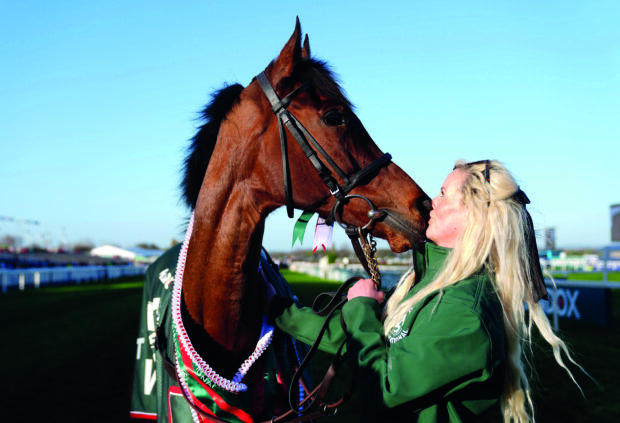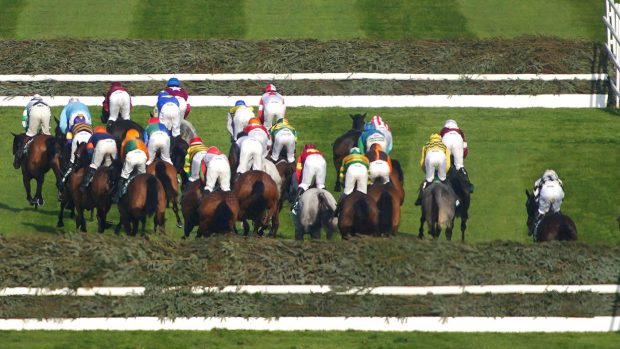Ahead of this weekend’s Randox Health Grand National (5.15pm on Saturday 10 April 2021), we thought we would give you a virtual tour around the entire course and provide you with all the information you need to know about the Grand National fences…
The Grand National fences
There are 16 fences on the Grand National and they are created with spruce from the Lake District. They are topped with at least 14 inches of spruce. The cores of 12 fences were rebuilt in 2012 in an effort to improve the safety of the race and they are now made of a flexible plastic material, which is more forgiving than the traditional wooden core fences.
- Fence one and 17
Height: 4ft 6 inches (1.37 m)
- Fence two and 18
Height: 4ft 7 inches (1.40 m)
- Fence three and 19 – open ditch
Height: 4ft 10 inches (1.47 m); fronted by a 6ft (1.83 m) ditch
This is the first big test in the race as it comes quite early on in the course as horses are finding their position and rhythm.
- Fence four and 20
Height: 4ft 10 inches (1.47 m)
- Fence five and 21
Height: 5ft (1.52 m)
- Fence six and 22 – Becher’s Brook
Height: 5ft (1.52 m), with the landing side six inches (15cm) to 10 inches (25cm) lower than the takeoff side.
The drop at this fence is prone to catching runners by surprise. The fence is named after Captain Martin Becher who fell there during the first Grand National and took shelter in the small brook running along the landing side of the fence while the remainder of the field tackled the obstacle.
- Fence seven and 23 – Foinavon
Height: 4ft 6 inches (1.37 m)
One of the smallest fences on the course, it was named in 1984 after the 1967 winner who avoided a mêlée at the fence to go on and win the race at outside odds of 100/1.
- Fence eight and 24 – Canal Turn
Height: 5ft (1.52 m)
This fence features sharp 90-degree left turn immediately after landing.
- Fence nine and 25 – Valentine’s Brook
Height: 5ft (1.52 m) with a 5ft 6 inches (1.68 m) brook
The fence was originally known as the Second Brook but was renamed after a horse named Valentine was reputed to have jumped the fence hind legs first in 1840.
- Fence 10 and 26
Height: 5ft (1.52 m)
- Fence 11 and 27 – open ditch
Height: 5ft (1.52 m), with a 6ft (1.83 m) ditch on the takeoff side
- Fence 12 and 28 – ditch
Height: 5ft(1.52 m), with a 5ft 6 inches (1.68 m) ditch on the landing side
- Fence 13 and 29
Height: 4ft 7 inches (1.40 m)
- Fence 14 and 30
Height: 4ft 6 inches (1.37 m)
This is the last fence on the final lap.
On the first lap of the race, runners then continue around the course to negotiate two fences which are only jumped once. They are:
- Fence 15 – The Chair
Height: 5ft 2 inches (1.57 m), preceded by a 6ft (1.83 m) wide ditch
This is one of the most popular jumps on the course for spectators, when they are permitted in normal pre-Covid years due to its sheer size and the fact it is located in front of the main grandstand.
- Fence 16 – Water Jump
Height: 2ft 6 inches (0.76 m)
Originally a stone wall in the very early runnings of the Grand National.
On the final lap, after the 30th fence, the remaining runners bear right, avoiding The Chair and Water Jump, to head onto a run-in to the finishing post. The run-in is not perfectly straight and is known as the ‘elbow’. It is one of the longest run-ins in the United Kingdom at 494 yards (452m) and can see dreams made and shattered.
You may also be interested in…

Who will win the Grand National? Have a flutter on your pick here…
Who will win the Grand National when the race gets underway today (10 April) at 5.15pm 2021? Here’s the full

How to watch Grand National 2025 live streams and TV coverage: your armchair viewing guide

Which race? Which day? What time? The full Grand National meeting racecard
On 8 April 2021 the Grand National meeting gets underway at Aintree Racecourse. Here we bring you a full day-by-day

Subscribe to Horse & Hound magazine today – and enjoy unlimited website access all year round
Keep up-to-date with all the latest news and updates from the Grand National meeting via the Horse & Hound website and read the full report in the 15 April issue of the magazine
Would you like to read Horse & Hound’s independent journalism without any adverts? Join Horse & Hound Plus today and you can read all articles on HorseandHound.co.uk completely ad-free




